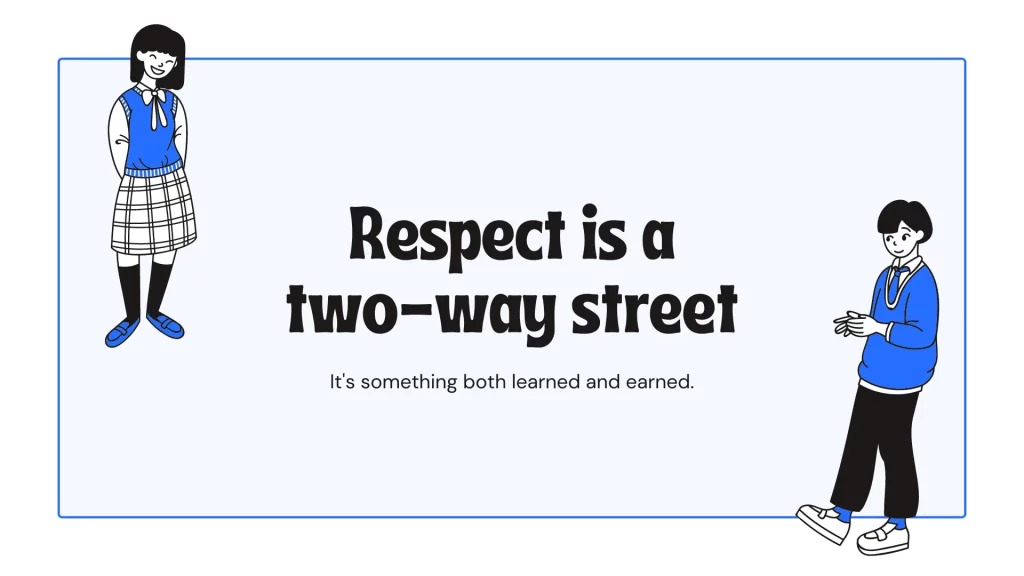1. Etiquette and Manners Paragraph
Etiquette and manners are like a guidebook for how we should behave in different situations. They help us show respect, consideration, and kindness to others. In Bangladesh, these customs play a crucial role in our culture. Saying “please” and “thank you” shows gratitude and politeness. When we greet others with a smile and a friendly “hello,” it makes them feel welcomed. Respecting our elders by addressing them with appropriate titles like “Uncle” or “Auntie” is a sign of deference. It’s also important to listen attentively when someone is speaking and not interrupt them. When we use utensils properly while eating, it reflects our upbringing and respect for others around us. Additionally, covering our mouth when we cough or sneeze is a way to keep others healthy and avoid spreading germs. These little acts of politeness and consideration make our society more harmonious and pleasant. Etiquette and manners are like the glue that holds our communities together, fostering goodwill and understanding among people of all ages.
Let’s Play a game of good manner:

Difficult Words for Etiquette and Manners Paragraph:
- Etiquette (শৃঙ্গারিক প্রক্রিয়া): The customary code of polite behavior in society or among members of a particular profession or group.
- Manners (শিষ্টাচার): Polite or well-bred social behavior.
- Deference (শ্রদ্ধা): Courteous regard for people’s feelings; a way of behaving that shows respect for someone or something.
2. Etiquette and Manners Paragraph
Etiquette and manners, the subtle but powerful tools of social cohesion, find profound significance in the cultural landscape of Bangladesh. Rooted in our heritage and values, these unwritten codes guide our interactions, transcending words to convey respect, understanding, and unity.
From the moment we exchange a warm “Salaam” as a greeting, we enter the realm of our etiquette. It’s not just a routine; it’s a reflection of our respect for one another. Addressing our seniors as “Dada” or “Apa” encapsulates our veneration for age and experience. These seemingly simple words carry a weight of tradition and respect that are integral to our social fabric.
Our dining etiquettes, marked by communal meals, are a testament to our interconnectedness. Sharing a plate, often a symbol of familial unity, extends beyond households to our society at large. The act of using the right hand for eating isn’t just a culinary preference; it’s an embodiment of our cultural norms that have been passed down through generations.

Non-verbal cues, those silent communicators, also play a pivotal role. Making eye contact during conversations denotes attentiveness and active engagement, while averting direct gaze signifies humility. The act of offering and accepting, even symbolic gestures, signifies generosity and unity. Removing shoes before entering a mosque reflects our respect for sacred spaces.
In today’s rapidly evolving world, our etiquette faces new challenges. The digital realm has transformed communication dynamics, influencing how we express our manners. While emojis replace facial expressions, and texts substitute for spoken words, the essence of our etiquette remains intact.
In Bangladesh, etiquette is more than a set of rules; it’s the embodiment of our identity. It reflects our collective values, our shared experiences, and our commitment to unity. As our nation strides forward, let us not forget the significance of these customs that have shaped us. Let us adapt, but not lose sight of the rich tapestry of our manners that connects us to our roots and binds us as one.
Difficult Words for Etiquette and Manners Paragraph:
- Cohesion (সংগতি): The action or fact of forming a united whole.
- Veneration (শ্রদ্ধা): Great respect; reverence.
- Integral (অবিচ্ছেদ্য): Necessary to make a whole complete; essential or fundamental.
- Culinary (রন্ধনীয়): Relating to cooking or the kitchen.
- Pivotal (মূল): Of crucial importance in relation to the development or success of something else.
- Averting (প্রতিকূল করা): To prevent or ward off.
- Emojis (ইমোজি): A small digital image or icon used to express an idea or emotion.
3. Etiquette and Manners Paragraph
Etiquette and manners serve as the social compass that guides our interactions, reflecting our respect and consideration for others. In the context of Bangladesh, where a rich tapestry of cultural values is woven, these unwritten codes of conduct hold significant importance. Our etiquette is intricately tied to our cultural heritage, defining the way we communicate, dine, and engage with each other.
Politeness and consideration manifest in various forms. When we address our elders with titles like “Apa” or “Bhaiya,” it signifies our respect for age and experience. Greeting with a warm “As-salaam alaykum” or “Hello” showcases our hospitality and inclusivity. During communal gatherings, sharing food from a common plate demonstrates unity and camaraderie. Using the right hand for eating, as the left is considered impolite, upholds cultural norms.
Moreover, our etiquette extends to non-verbal communication. Making eye contact while speaking signifies attentiveness while avoiding direct eye contact is often seen as a sign of modesty. Offering and accepting items, even if just as a gesture, symbolizes generosity and reciprocity. In mosques, we take off our shoes before entering, showing reverence for the sacred space.

These etiquettes are not just social niceties; they are the threads that weave the fabric of our society. They preserve the harmony and cohesion that define our community interactions. However, as times evolve and cultures blend, the lines of etiquette can become blurred. The younger generation’s adoption of global communication styles can sometimes challenge traditional norms. Yet, striking a balance between preserving our cultural values and adapting to modern dynamics is essential.
In conclusion, etiquette and manners in Bangladesh encapsulate our cultural ethos and enhance social interactions. They serve as a reminder of the respect we owe to our elders, the warmth we extend to newcomers, and the unity we find in shared meals. As we navigate the complexities of a changing world, maintaining a strong foundation of etiquette ensures that our cultural identity remains intact while we embrace the virtues of progress and inclusivity.
Difficult Words for Etiquette and Manners Paragraph:
- Compass (দিকনির্দেশক): A device used for determining directions.
- Tapestry (তাপিশ্যরি): A fabric consisting of a warp upon which coloured threads are woven by hand to produce a design.
- Inclusivity (সমাহিততা): The quality of including different types of people and treating them all fairly and equally.
- Camaderie (মিত্রভাব): Mutual trust and friendship among people who spend a lot of time together.
- Reverence (শ্রদ্ধা): Deep respect for someone or something.
- Modesty (মননীয়তা): The quality or state of being unassuming in the estimation of one’s abilities.
- Reciprocity (পরস্পর প্রতিদান): The practice of exchanging things with others for mutual benefit.
- Sacred (পবিত্র): Connected with God or a god or dedicated to a religious purpose and so deserving veneration.
- Cohesion (সংকৃতি): The action or fact of forming a united whole.
- Ethos (চরিত্র ও আচরণের ধারাবাহিক পর্যায়): The characteristic spirit of a culture, era, or community as manifested in its beliefs and aspirations.
4. Etiquette and Manners Paragraph
Etiquette and manners are the invisible threads that weave through the fabric of our society, dictating how we interact, communicate, and navigate the intricate web of human relationships. In the context of Bangladesh, a nation steeped in cultural diversity and rich traditions, these social norms hold a special significance, acting as the glue that binds us together.
In our interactions, etiquette acts as a guide, helping us navigate the nuances of social dynamics. A warm smile and a respectful nod are universal gestures that transcend language barriers, conveying friendliness and acknowledgement. Addressing our elders with honorifics like “Apa” or “Bhaiya” signifies reverence for age and experience. These simple gestures carry layers of meaning that are deeply ingrained in our cultural DNA.
The dining table is another arena where etiquette plays a vital role. Sharing food from a communal plate symbolizes our unity and shared humanity. As we partake in the traditional feast of rice and curry, we engage in a centuries-old ritual that brings families and communities closer. Using the right hand for eating, as the left is considered impolite, is not just a matter of convenience but a reflection of cultural norms passed down through generations.
Non-verbal communication is equally significant. Making eye contact while conversing reflects attentiveness and respect. In contrast, averting direct eye contact is often considered a sign of humility, especially when speaking to authority figures or elders. The act of offering and accepting items, even if just a token, embodies the values of generosity and mutual support. Removing our shoes before entering a mosque showcases our reverence for the sacred space.
Yet, the landscape of etiquette is not static; it evolves with the changing tides of time. As globalization blurs boundaries and cultures intermingle, our etiquettes might adapt to new ways of communication. The younger generation’s affinity for digital interactions can sometimes challenge traditional face-to-face manners. However, it’s important to recognize that as we embrace modernity, we can still uphold the values of respect and consideration that form the essence of our etiquette.
In Bangladesh, etiquette goes beyond mere social interactions; it is deeply woven into the fabric of our society. It reflects our commitment to unity and harmony, our veneration of age and wisdom, and our desire to foster meaningful connections. As we embrace the complexities of the 21st century, it’s essential to preserve the essence of our etiquette while embracing the opportunities that a globalized world presents.

In conclusion, etiquette and manners in Bangladesh are not just a set of rules; they are the embodiment of our cultural values and identity. They transcend generations, serving as a bridge between the past and the future. These customs remind us of the importance of respect, kindness, and understanding in a world that is increasingly interconnected yet remarkably diverse. By upholding these traditions, we ensure that the essence of our culture remains vibrant and relevant, while we forge ahead into a future that holds both challenges and promise.
Difficult Words for Etiquette and Manners Paragraph:
- Invisible (অদৃশ্য): Unable to be seen; not visible to the eye.
- Nuances (সূক্ষ্ম পার্থক্য): A subtle difference or distinction in expression, meaning, or response.
- Acknowledgement (স্বীকৃতি): Acceptance of the truth or existence of something.
- Reverence (শ্রদ্ধা): Deep respect for someone or something.
- Ingrained (ঘটিত): Firmly fixed or established; difficult to change or remove.
- Partake (ভাগ নেওয়া): To join in an activity or participate.
- Ritual (আচার প্রথা): A religious or solemn ceremony consisting of a series of actions performed according to a prescribed order.
- Essence (মৌলিক গুণ): The intrinsic nature or indispensable quality of something, especially something abstract, that determines its character.
- Veneration (শ্রদ্ধা): Great respect; reverence.
- Embrace (গ্রাহ্য করা): To accept willingly and enthusiastically.
- Intermingle (মিশ্র হত্তয়া): Mix or mingle together.
- Affinity (স্বাদস্থান): A natural liking for and understanding of someone or something.
- Digital interactions (ডিজিটাল অবলম্বন): Communication or engagement using digital devices and platforms.
Most Important Paragraph
| Metro Rail Paragraph | Click Here |
| Moonlit Night Paragraph | Click Here |
| Online Class and Traditional Class Paragraph | Click Here |
| Price Hike paragraph | Click Here |
| Road Accident paragraph | Click Here |









